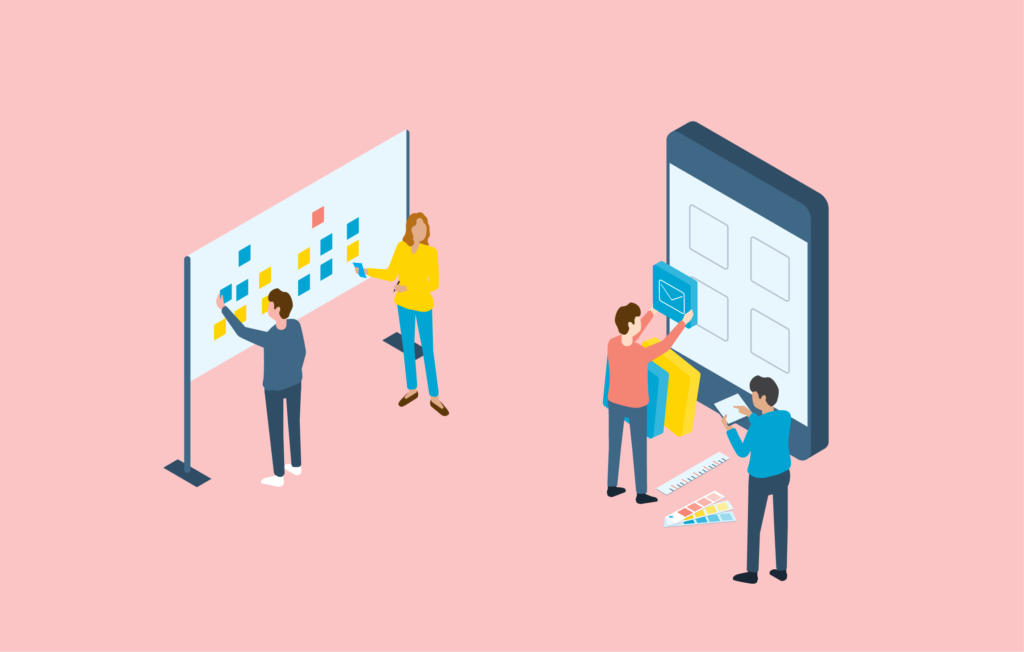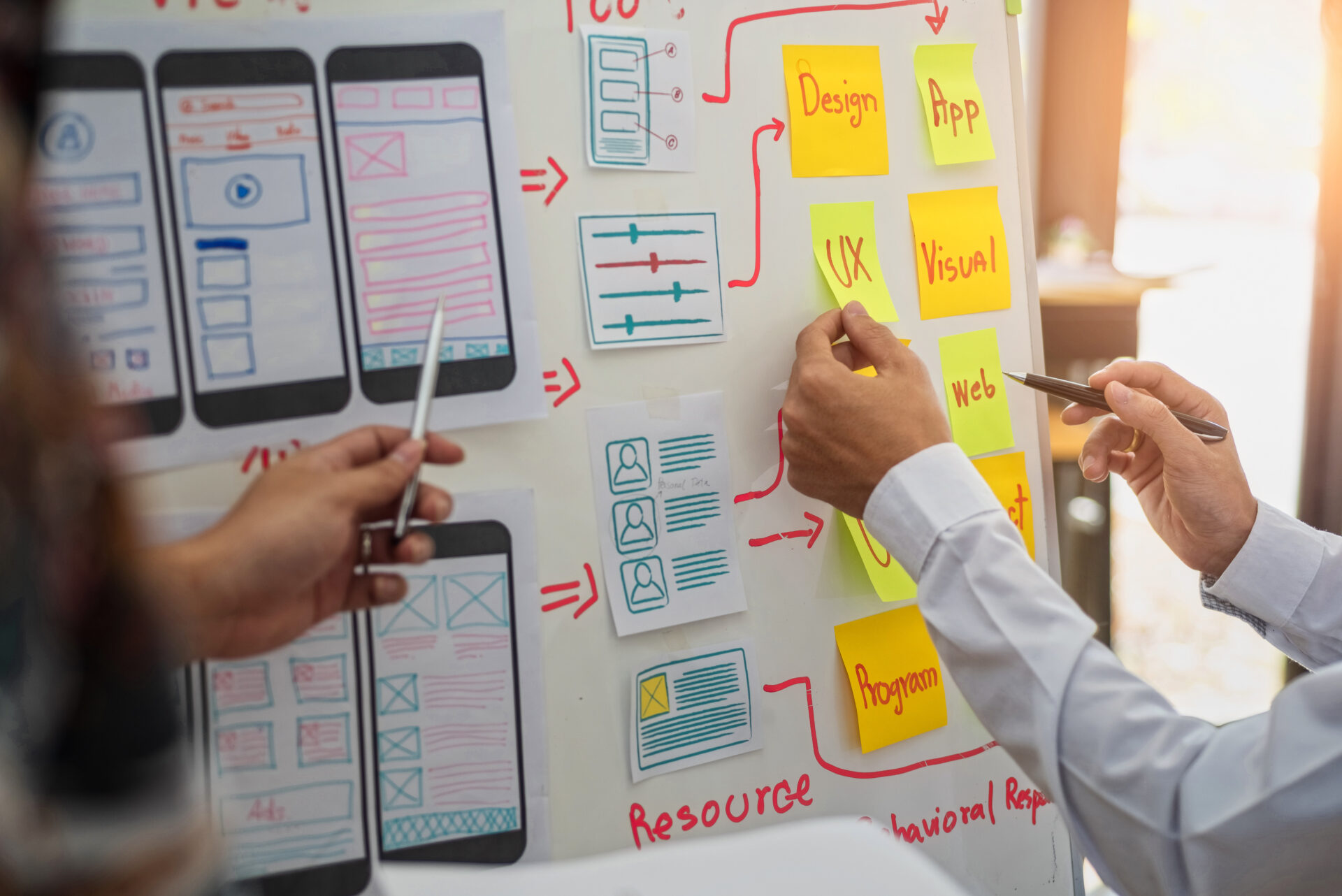In an era where digital interaction is integral to organizational success, the importance of User Experience (UX) has magnified. As your digital product design and innovation agency, we recognize the centrality of UX in not only meeting but exceeding the expectations of your users. This is particularly crucial for enterprise-level organizations, where the digital landscape is often complex and laden with unique challenges.

Trending UX Innovations:
Staying ahead in the digital arena requires a keen awareness of emerging UX trends. In 2023, notable trends include generative AI, large font size implementation, accessibility enhancements, light mode, augmented reality, and data-driven design personalization3. Adapting to these trends not only improves the user experience but also ensures that your digital products remain contemporary and competitive.
Enhancing Customer Support through UX
Enterprise UX plays a pivotal role in customer support, with features like live chat and support tools becoming increasingly integral. By understanding and leveraging the capabilities of UX design, organizations can significantly improve their customer support channels, ensuring that users have the resources they need when they need them4.
Internal Efficiency and UX Design
Unlike other UX designs, Enterprise UX design often serves the needs of internal users rather than external consumers, focusing on streamlining internal processes, reducing errors, and ultimately boosting productivity. By developing intuitive and user-friendly interfaces, organizations can ensure that their employees have the tools they need to succeed, making the workplace not only more efficient but also more enjoyable5.
In summary, the realm of UX design is expansive, with a wide array of strategies and techniques available to enhance both customer and employee experiences. By partnering with us, you’re not only investing in top-tier UX design but also ensuring that your organization remains agile, innovative, and ready to meet the demands of the modern digital landscape. Our agency is committed to delivering tailored UX solutions that drive tangible business results, propelling your organization forward in today’s competitive digital frontier.
Driving Business Impact through UX
The realm of User Experience (UX) Design is vast, encompassing various facets that significantly impact business outcomes. When effectively implemented, UX design can bring about a notable return on investment (ROI), and foster customer retention—two critical elements for business sustainability and growth.
The ROI of UX Design:
The potential return on investment (ROI) from UX design is substantial. A well-designed user interface could lead to a ROI of 9,900%, as every US$1 invested in UX design can result in a return of US$1001. Moreover, companies with top-notch design practices tend to grow twice as fast as the industry benchmark growth rate. This compelling data underscores the business impact that thoughtful UX design can have, especially in terms of enhanced customer satisfaction and brand loyalty2.
Increased Conversion Rates and Customer Satisfaction:
A compelling example of the ROI of UX Design comes from Bank of America which embarked on a UX redesign project to refine its online enrollment application for online banking. By focusing on yield (percentage of customers completing the process) as the primary metric, and through prototyping and testing various design solutions, the redesign strategy proved successful. In the week the new registration form was launched, the yield metric nearly doubled, exceeding the desired ROI benchmark1.
General Electric (GE) also invested in UX by creating a common software platform to address the inconsistency in software quality across different divisions. This initiative led to a 100% productivity gain in development teams and saved an estimated $30 million for the company in the first year following its launch1.
Strategic and intentional UX has the potential to raise conversion rates by as much as 400%, illustrating the substantial business value that can be derived from investing in UX design2.

Customer Retention:
- Understanding Customer Needs:
- Through user research, surveys, interviews, and analytics, UX design facilitates a deeper understanding of customer needs, preferences, and pain points, which is pivotal for crafting solutions that resonate with the target audience3.
- Identifying and Addressing “Red Flag” Behaviors:
- A critical aspect of UX design is the ability to identify “red flag” behaviors, such as points where customers tend to drop off during the onboarding process. By analyzing churn data and other relevant metrics, businesses can “plug the holes” to maximize results and improve customer retention3.
- Improving Customer Engagement:
- Adopting testing methods to ensure deliverables are bug-free and function as intended, provides the user with a seamless experience which, in turn, helps businesses improve customer retention and increase customer engagement4.
The aforementioned examples and strategies elucidate the instrumental role of UX design in driving favorable business outcomes, both in terms of ROI and customer retention. By investing in UX design, businesses not only enhance the user satisfaction but also set a strong foundation for long-term customer loyalty, which is indispensable for sustaining a competitive edge in the modern digital marketplace.

Fostering Innovation for Competitive Edge:
In addressing the topic of User Experience (UX) with a focus on innovation and future-proofing digital products for large organizations, several aspects can be considered to provide a well-rounded view:
Competitive Differentiation through Innovative UX Design:
- Design-Led Organizations: The Design Management Institute studied the S&P companies over a 10-year period and found that design-led organizations outperformed their peers by 228%1.
- Differentiated Digital Experiences: By focusing on user-centric product strategies and design, organizations can create differentiated digital experiences, igniting innovation and generating substantial value, as highlighted by a case study from UXReactor2.
- Design as a Competitive Edge: Especially in commoditized industries, design drives winning differentiation through experience3.
- Investing in UX for Competitive Advantage: In the digital age, investing in UX design provides a competitive advantage by helping companies stand out and succeed in the online space4.
Mechanisms for Innovation in UX:
- Improving Market Fit: Products and services conceptualized through user research, ethnographic study, and design-thinking have a tighter market fit, making them more resilient to market shifts or disruptions5.
- Promoting Innovation: Organizations that invest in great design tend to be more innovative, readily discarding outdated approaches to embrace new ways of thinking and providing value5.
- Creating Systems of Experience: Looking at systems as a whole, rather than in isolation, can lead to tighter integration of end-to-end experiences that are much harder to disrupt and provide more overall value5.
Future-Proofing Digital Products through UX Design:
- Design Systems as a Foundation: Design systems are foundational for future-proofing UX, accounting for the user’s needs, wants, and limitations, thereby ensuring that the user interaction remains intuitive and goal-oriented over time6.
These points highlight how a meticulously crafted UX design not only fosters innovation but also paves the way for competitive differentiation and future resilience in digital products. By embedding design-thinking across organizational processes and continually adapting to user needs and market dynamics, enterprises can significantly bolster their market stance and readiness for future challenges.
Enhancing Efficiency and Productivity through User Experience (UX) Design
Addressing the topic of Enhancing Efficiency and Productivity through User Experience (UX) Design, various large organizations have leveraged UX principles to streamline operations, improve employee interaction with internal tools, and enhance overall productivity. Here’s a breakdown of how UX contributes to efficiency and productivity, illustrated with real-world examples:
Streamlining Processes:
- Google’s Material Design:
- Google exemplifies how a standardized UX design can significantly streamline operations. Through its Material Design, Google established a comprehensive set of design guidelines, principles, and components that enabled designers and developers to create visually consistent and intuitive experiences across a broad range of products like Gmail1.
- Industry Leaders’ UX Projects:
- Companies like Airbnb, Spotify, Uber, and Slack have had successful UX design projects that addressed various challenges and implemented solutions to improve user interactions and streamline processes2.
Employee Training and Adoption:
- Airbnb’s User Research:
- Airbnb employed UX research, observing user behavior to uncover design opportunities. By understanding how users interacted with their platform, they could enhance the design to make it more intuitive, reducing the learning curve and training time for both employees and users3.
- B2B Redesign Case Studies:
- In the B2B space, UX redesign initiatives have been instrumental in showcasing the ROI of UX to company executives. By demonstrating the real-life benefits through case studies, UX teams have made compelling cases for investing in UX design to improve efficiency and productivity4.
These examples underscore the potential of well-thought-out UX design in streamlining operations and improving productivity, not only within digital platforms but also in how employees interact with these platforms. Through careful analysis, iterative design, and user feedback, companies can significantly enhance efficiency, reduce training time, and ultimately contribute to better business outcomes.
Unveiling the Blueprint of Effective UX: Insightful User Research and Measurable Outcomes
In the ever-evolving realm of digital design, understanding the user is the cornerstone of crafting experiences that not only resonate but drive business success. This journey of understanding begins with robust User Research, a facet deemed integral in the broader UX design process. It’s not just about aesthetics or interface; it’s about diving deep into the needs, behaviors, and challenges of the user. Subsequently, the insights garnered from user research become the guiding light for design decisions, ensuring that the solutions devised are not just visually appealing but significantly functional and user-centric.
User Research: The Compass of Design Direction
User research is the proverbial compass that provides a clear sense of direction in the vast ocean of design possibilities. It’s about getting to know the target users, comprehending who you are designing for, why, and the problems your target users encounter concerning your product or service1. A practical illustration of this is seen in how Airbnb utilized user behavior observations to uncover design opportunities. Through planned user research, Airbnb was able to discern user interactions and preferences, which in turn fueled better design solutions2.
Moreover, the digital behemoths like Amazon, Airbnb, and Dropbox have harnessed the power of user research to refine their UX, underscoring the critical role it plays in enhancing design and ultimately, the user experience3. It’s an endeavor that transcends assumptions, providing a tangible foundation upon which design ideas can flourish. User research, as outlined by CareerFoundry, is about designing to fulfill the user’s actual needs, not what we assume their needs to be. It opens up a realm of design possibilities, ensuring a competitive edge while saving time and money4.
Transitioning from Insight to Measurement: The Role of KPIs
Transitioning from the insights derived from user research to the measurable realm is where Key Performance Indicators (KPIs) come into play. KPIs are instrumental in measuring and proving the performance of UX efforts5. They provide a quantifiable means to track and analyze various UX metrics, offering valuable insights into how users are interacting with designs and where areas of improvement lie6.
Some common UX KPIs include metrics such as user satisfaction, task completion rate, and bounce rate, which can be collected through various methods like surveys, analytics, and user testing7. For instance, a marketing team aiming to increase brand awareness might track metrics like follower growth rate on social platforms and brand mentions, providing a measurable approach to gauge the effectiveness of their UX strategies8.
In conclusion, the synergy between insightful user research and measurable outcomes through KPIs forms the bedrock of effective UX design. It’s a blueprint that ensures not just a visually delightful user interface but a user-centric design that resonates and achieves business objectives.
Ensuring Compliance and Accessibility:
Addressing the intricacies of User Experience (UX) in the realm of digital compliance and inclusive design is paramount for any organization aiming to create responsible and accessible digital products. Below, the discussion expands on these two pivotal aspects:
Ensuring Digital Compliance:
- Understanding Regulatory Requirements:
- Almost every industry encounters regulatory oversight, which is primarily aimed at safeguarding consumer privacy, security, and sometimes physical safety. The regulations encapsulate the collective will of the society and serve as an extension of ethical design practices1.
- Innovative UX Design within Compliance Framework:
- Regulatory requirements should not be viewed as constraints but as inputs that shape the design process. Around 95% of product requirements stem from Marketing or Product Development, not from regulatory or compliance sides. Hence, innovative solutions can still thrive within a compliance-heavy environment1.
- Early Engagement and Collaboration:
- Engaging with compliance requirements from the early stages of product design can prevent costly design alterations down the line. For example, in the telecom sector, engaging with compliance lawyers to meet FCC’s data security requirements led to the successful launch of a new security system, meeting the regulatory deadline1.
Advancing Inclusive Design:
- Universal Usability:
- The core objective of UX is to design products that cater to every potential user, irrespective of their abilities. The best UX is deemed as accessible UX2.
- Examples of Inclusive Design:
- Inclusive design has been showcased in various case studies, one of which is the creation of Good Grips kitchen utensils by OXO, designed to address usability for all individuals3.
- Methodological Approach:
- Inclusive design emanates from digital environments and seeks to include and learn from a diverse range of human perspectives. It’s a methodology that embraces the full spectrum of human diversity4.
- Commercial Implementation:
- Case studies reflect how inclusive design can foster innovation and enhance design in a commercial setting. It melds inclusivity with style, resulting in products that are both comfortable and effective5.
- Adherence to Legal Standards:
- Inclusive design also aligns with legal standards such as the American Disabilities Act (ADA) of 1990, ensuring digital products are accessible to a diverse user base6.
These elucidations underscore the significance of intertwining digital compliance and inclusive design within the UX framework, which not only aligns with legal and ethical standards but also broadens the scope of usability, fostering a more inclusive digital landscape.
Embracing technological advancements within the realm of User Experience (UX) design
In addressing the topic of embracing technological advancements within the realm of User Experience (UX) design, there are two primary subpoints: the integration of emerging technologies and the necessity of mobile optimization. Here’s a breakdown of each subpoint with reference to the latest trends and real-world examples.
Integrating Emerging Technologies: AI, VR, and AR
Emerging technologies such as Artificial Intelligence (AI), Virtual Reality (VR), and Augmented Reality (AR) are significantly impacting the UX design landscape. These technologies are extending the boundaries of digital design by opening new avenues for creating immersive and interactive user experiences. Unlike traditional 2D interfaces, AR and VR enable a 3-dimensional interaction space, allowing users to interact with digital content in a more natural and engaging manner1.
Moreover, AR and VR are no longer confined to gaming; they are stepping into the limelight of UX design. For instance, envision a scenario where while shopping for a new couch, you can place a virtual version of it right next to your coffee table in your living room. This level of interaction and visualization is becoming a reality in 2023, making the shopping experience more interactive and informed2.
AI, along with other technologies like Machine Learning and the Internet of Things (IoT), is reshaping almost every industry globally, and UX design is certainly no exception. These tech innovations are evolving rapidly, posing a challenge and an opportunity for UX designers to keep up and leverage these technologies to enhance user experiences3.
Mobile Optimization
The necessity for mobile optimization in UX design stems from the widespread prevalence and usage of smartphones and tablets. Although not covered in the sourced materials, it’s well understood in the industry that ensuring a seamless user experience on mobile devices is crucial as the number of mobile users continues to grow. A mobile-optimized UX design ensures that the digital product is easily accessible, navigable, and usable on various mobile devices, thus meeting the expectations of modern users.
In conclusion, the integration of emerging technologies like AI, VR, and AR, along with mobile optimization, are pivotal in enhancing the UX design, making it more interactive, engaging, and accessible across various devices. By embracing these technological advancements, UX designers can create innovative solutions that meet the evolving needs and expectations of users in this digital era.
Fostering collaboration and seamless integration in the realm of User Experience (UX)
Addressing the various facets of fostering collaboration and seamless integration in the realm of User Experience (UX) is crucial for the success of digital projects within large organizations. Here’s an elaborated discussion on Point 7 and its subpoints:
Promoting Collaboration and Seamless Integration:
1. Cross-Functional Collaboration:
- Strategies for Fostering Collaboration:
- Early Engagement: It’s recommended to involve developers as stakeholders early in the design process, ensuring that they have a say in the UX design from the beginning, which is crucial for fostering a collaborative environment1.
- Regular Check-ins: Having frequent check-ins between designers, developers, and stakeholders is essential to ensure everyone is aligned and to facilitate the iterative nature of the UX design process1.
- Shared Goals: Establishing shared goals among UX designers, developers, and various teams can streamline processes and create better products that meet user needs and business objectives2.
- Benefits of Collaboration:
- Better Products: Collaboration between UX designers and other stakeholders is essential for creating user-centered products that not only address user needs but also streamline internal processes3.
- Learning Opportunities: Collaborative settings offer valuable opportunities for all involved parties to learn how users interact with products and services firsthand, fostering a shared understanding and alignment4.
2. Seamless Integration:
- Integration with Existing Systems:
- While the sources didn’t provide specific examples or methods, it’s generally known in the industry that seamless integration of new UX designs with existing systems and technologies is a complex yet crucial task. It ensures that the new designs work harmoniously with the existing infrastructure, minimizing disruptions and ensuring a smooth transition.
- Challenges and Solutions:
- Again, while the specifics weren’t covered in the sources, it’s well understood that challenges may arise due to technological, process, or cultural differences within large organizations. Solutions may include thorough planning, effective communication, and possibly leveraging middleware or other integration technologies to bridge the gap between new and existing systems.
The synthesis of the information suggests that promoting a culture of collaboration and ensuring seamless integration are pivotal in navigating the complex landscape of UX design within large organizations. By engaging stakeholders early, aligning on shared goals, and addressing integration challenges head-on, organizations can significantly enhance the quality and impact of their digital products.
Building for Scalability and Continuous Growth
In an ever-evolving digital landscape, scalability and continuous growth are paramount for large organizations aiming to stay competitive and meet the expanding needs of their user bases. Your agency can play a pivotal role in aiding enterprises on this front through the development of scalable design systems and the implementation of user feedback loops.
Scalable Design Systems Development:
Scalable design systems are essentially a collection of repeatable design patterns, guidelines, and coded components that allow organizations to maintain consistency while scaling their digital products across different platforms and user interfaces.
- Examples of Scalable Design Systems:
- ABB: The Switzerland-based holding company ABB created a design system to ensure a consistent look and feel across hundreds of software products, many of which power the mechanical systems in factories, mines, and other industrial sites1.
- IBM Carbon: IBM’s Carbon Design System is another exemplary case of a scalable design system that provides a suite of tools, including UI kits and guidelines for designers, developers, and content authors2.
- Benefits:
- Efficiency: By using a system of reusable components and patterns, organizations can build and iterate on designs more efficiently, saving both time and resources3.
- Consistency: Ensures a cohesive user experience across all digital touchpoints, which is crucial for brand recognition and user satisfaction4.
- How Your Agency Can Help:
- Custom Design System Development: Tailor design systems to the unique needs and branding of each client.
- Design System Audit and Optimization: Evaluate existing design systems and suggest improvements for better scalability and efficiency.
- Training and Documentation: Provide training and comprehensive documentation to ensure smooth adoption and ongoing maintenance of the design system.
User Feedback Loops:
User feedback loops are systematic processes of collecting, analyzing, and acting upon user feedback to continuously improve the user experience.
- Benefits:
- Implementing User Feedback Loops:
- Collecting Feedback: Utilize various channels such as surveys, social media, and user interviews to collect feedback.
- Analyzing Feedback: Analyze the feedback to derive actionable insights that can help enhance the user experience.
- Acting on Feedback: Make necessary adjustments to the product based on the feedback collected and analyzed.
- How Your Agency Can Help:
- Feedback System Setup: Assist in setting up systems and processes for collecting and analyzing user feedback.
- Feedback Analysis Services: Provide services for analyzing user feedback and deriving actionable insights.
- Iterative Design and Development: Work closely with clients to iteratively design and develop improvements based on user feedback.
Through the strategic development of scalable design systems and the implementation of user feedback loops, your agency can significantly contribute to the scalability and continuous growth of large organizations in the digital realm. By offering custom solutions and expert guidance, you can help clients adapt to changing market demands, maintain a competitive edge, and deliver exceptional user experiences.
Customization & Personalization in User Experience Design
In addressing the topic of customization and personalization in User Experience (UX) design, a multitude of strategies and real-world applications can be observed. These are aimed at tailoring the user interface and experience to meet individual preferences and needs, which in turn, significantly enhances user engagement and satisfaction. Here are some of the sub-points fleshed out, with references to external sources for further insights:
- Types of Personalization:
- Explicit Personalization: This involves customizing content or product recommendations based on explicit information or preferences provided by the user, such as demographic information and interests1.
- Implicit Personalization: This type relies on analyzing user actions like search history and previous purchase history to understand user preferences and provide personalized recommendations accordingly1.
- Contextual Personalization: Factors like location, device type, time of day, weather, or other contextual cues are considered to tailor content or product recommendations, leveraging real-time data1.
- Examples of Personalization Strategies in UX Design:
- Personalized Dashboards and Home Pages: Customizing the main page and/or the dashboard that welcomes users to the product is a common personalization technique. This provides a sense of familiarity and comfort, enhancing user satisfaction1.
- Personalized Content Suggestions: By analyzing user behavior, platforms can suggest content that aligns with the user’s preferences and interests, enhancing engagement and satisfaction2.
- Personalized Onboarding: Tailoring the onboarding process to individual users can help in making the user feel valued, and can also provide a smoother transition into using the platform2.
- Real-World Examples:
- Amazon: Amazon personalizes the home page based on your purchase history, wishlist, and recent search history to provide product recommendations, making it easier for users to discover new items that align with their interests1.
- Netflix: Netflix is renowned for its personalized recommendations. It utilizes viewing history to suggest shows and even personalizes the thumbnails shown to different users based on their genre preferences1.
- Airbnb: The platform personalizes the home page based on upcoming stays and recommends locations within driving distance of the user’s current location, enhancing the overall user experience3.
- Benefits of Personalization:
- Increased User Engagement: Personalization increases relevance, which in turn, increases user engagement. For instance, emails with personalized subject lines witness a 26% rise in open rates4.
- Enhanced User Satisfaction: Users are more likely to be satisfied with a platform that caters to their personal preferences and needs.
- Hyper-Personalization:
- A step beyond traditional personalization, hyper-personalization understands the context alongside past behavior to provide highly tailored experiences. It’s about leveraging real-time data to offer a more granular level of personalization5.
- Challenges and Considerations:
- Privacy Concerns: As personalization relies on data collection, ensuring data privacy and compliance with regulations is crucial.
- Technical Complexity: Implementing personalization at scale requires robust technological infrastructure and capabilities.
By understanding and leveraging the different facets of personalization in UX design, platforms can significantly enhance the user experience, leading to better user engagement, satisfaction, and ultimately, business success.
Case studies and best practices in the field of UX design
In this section, we’ll delve into some riveting case studies and best practices in the field of UX design, illustrating how meticulous attention to user experience can significantly amplify the success of digital projects. These real-world examples underscore the transformative power of UX design in solving complex problems, enhancing user satisfaction, and ultimately, driving business growth.
- Mercedes-Benz Ukraine Car Dealer Website Redesign by Fulcrum:
- Project Brief: The task was to transition from a template-based website to a custom-designed, user-friendly platform that could bolster user trust and streamline maintenance.
- Outcome: A well-structured, intuitive website that enhanced user interactions, facilitating easy access to services and products offered by Mercedes-Benz Ukraine1.
- Galaxy Z Flips 5G Website by DFY:
- Project Brief: This project entailed the comprehensive design of a website to effectively illustrate and demonstrate the upgrades of the Galaxy Z Flip 5G over previous models, while fostering interactive communication with customers.
- Outcome: A visually engaging, interactive platform that provided clear, accessible information on the product features, thus enhancing user engagement and satisfaction1.
- Jambb Social Platform by Finna Wang:
- Project Brief: The goal was to create a platform to assist creators in growing their communities by recognizing and rewarding their supporters, addressing the challenge of acknowledging non-monetary contributions.
- Outcome: A platform designed with comprehensive user flows, wireframes, and usability testing, eventually fostering a more inclusive, rewarding environment for both creators and their supporters1.
- GnO Well Being – Branding, Web Design & UX:
- Project Brief: The task was to design a creative illustration website to present and sell a designer blanket aimed at promoting better sleep and overall health.
- Outcome: A well-crafted, user-centric website that effectively conveyed the brand message and facilitated user interactions2.
- Liquidplanner’s Usability Improvement:
- Project Brief: Liquidplanner, a cloud-based project management system, needed a solution to help users create dashboards more efficiently.
- Outcome: Through a meticulous UX design process, the usability of the system was significantly improved, enabling quicker dashboard creation and enhancing user satisfaction3.
- The UX Fund Experiment:
- Project Brief: An experiment named the “UX Fund” was initiated with a $50,000 investment in companies focusing on delivering superior user experiences, with a hypothesis that the ROI of UX would be reflected in their stock prices over time.
- Outcome: Over a ten-year period (2006 to 2016), the “UX Fund” yielded a remarkable 450% return, underlining the long-term financial viability of investing in superior UX design4.
These compelling case studies exhibit the vast spectrum of challenges that can be adeptly addressed through proficient UX design, reaffirming the importance of investing in user experience to achieve notable business outcomes. Moreover, they serve as a testament to the multifaceted value that our agency can bring to your organization by meticulously crafting user-centric digital solutions tailored to your unique needs and objectives.
Elevating Digital Prowess: Unveiling New Avenues for UX Mastery”
In the swiftly evolving digital landscape, staying ahead necessitates a continual refinement of skills and understanding of the latest User Experience (UX) trends. Engaging with an agency committed to empowering teams with the requisite knowledge and expertise ensures that digital products not only resonate with audiences but also drive tangible business outcomes. Here’s how a well-equipped agency can fuel a journey towards UX mastery:
- Workshops and Training Sessions:
- Comprehensive Courses: A rich learning experience is provided through all-encompassing courses on UX and UI design, akin to offerings by Experience Haus, where real projects form the core of the learning trajectory1.
- Flexible Learning Modalities: Whether on-site or online, tailored training programs, much like those from the American Graphics Institute, fit varied schedules and learning preferences, from short-term classes to multi-week certification programs2.
- Enterprise-centric Workshops: Specialized workshops, reminiscent of the Enterprise UX & UI Design Workshop by Tonex, are crafted to address the unique UX challenges encountered in large organizational settings, honing a team’s expertise to excel in UX and UI design3.
- Curated UX Workshops:
- Problem-Solving Workshops: Engage in UX workshops designed to unravel design challenges and foster cross-functional collaboration, akin to the methodologies espoused by Nielsen Norman Group4.
- Continuous Learning Opportunities:
- Subscription-based Learning: A subscription-based learning platform provides an avenue for teams to access updated materials, webinars, and interactive sessions on the latest UX trends and best practices.
- Accredited Learning Collaborations: Through partnerships with educational institutions, accredited UX design courses are offered, ensuring a gold standard of learning and certification.
- Industry Engagement:
- Interactive Industry Events: Engaging with the global UX community through hosted or sponsored UX design events, conferences, and meetups paves the way for networking and collective learning.
- Expert-Led Sessions: Benefit from sessions conducted by industry veterans, shedding light on emerging UX technologies and methodologies, thereby fostering a culture of knowledge sharing and continuous dialogue.
- Online Resources:
- Resourceful Online Library: A well-stocked online library with insightful articles, videos, and case studies on UX design facilitates self-paced learning and reference.
- Monthly UX Digest: Monthly newsletters encapsulate the latest UX trends, case studies, and best practices, ensuring a constant update with the evolving UX domain.
- Feedback-Driven Improvement:
- Feedback Channels: Post-training feedback surveys are integral to a learning-centric approach, helping gauge the effectiveness and relevance of the training content.
- Ever-evolving Course Material: Continuous refinement of course material based on the latest industry trends, feedback, and technological advancements ensures the learning experience remains relevant and up-to-date.
Engaging with an agency offering a plethora of learning opportunities elevates UX acumen to new heights, ensuring digital endeavors are not only user-centric but also competitively advantageous in the bustling digital marketplace. The journey towards superior digital innovation begins with a single step – and having a dedicated agency provides guidance every step of the way, ensuring a prosperous digital voyage.

Conclusion
In traversing the complex landscape of digital innovation, the pivotal role of User Experience (UX) design cannot be overstated. It’s an indispensable asset that underpins the success of digital platforms, ensuring they resonate with the users while meeting the strategic business objectives. Our agency is adept at navigating this intricate domain, offering a blend of expertise, innovation, and a meticulous approach to design that is data-driven and user-centric.
As delineated throughout this article, our comprehensive services address a multitude of UX facets—from driving business impact to ensuring compliance and accessibility. We are committed to fostering a collaborative environment that transcends departmental silos, ensuring seamless integration and alignment with your organization’s broader goals. By leveraging the latest technological advancements and adhering to industry best practices, we provide a robust foundation for your digital products to thrive in a competitive market.
Moreover, our emphasis on education and continuous learning ensures that your team remains at the forefront of UX design trends, equipped with the knowledge and skills necessary to sustain a trajectory of growth and innovation.
We invite you to engage with us for a personalized consultation. Let’s explore together how our adept design strategies and solutions can be tailored to meet your unique needs, ensuring your digital platforms not only meet but exceed the expectations of your users, thereby driving enhanced satisfaction, loyalty, and business success.
In a world where the digital experience is often the first and most enduring interaction your customers have with your brand, investing in superior UX design is not merely a good practice—it’s a business imperative. Our agency is poised to be your trusted partner in this endeavor, propelling your digital presence to new heights of excellence.
Until next time explore webkeyz’s case studies
and Keep Thinking!





